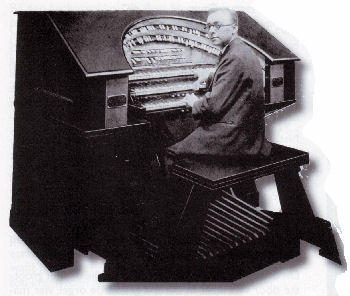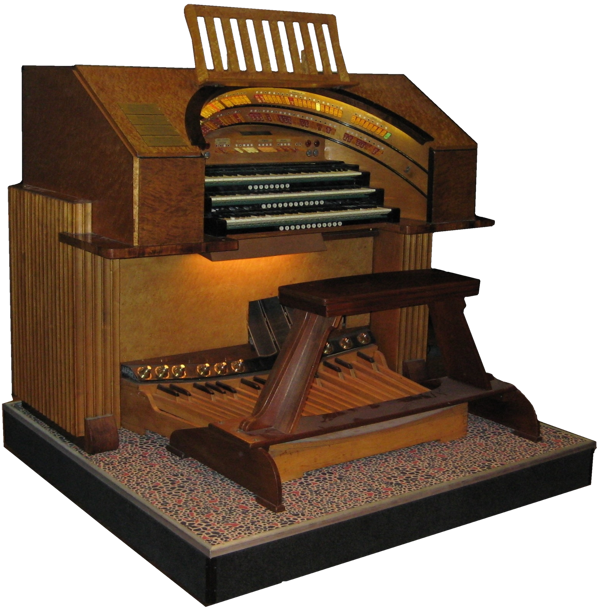Continuation AVRO-organ (see part 5)
The situation sounds strangely familiar.........
In the second (and final) specification design only the three softest stops of the Trocadero are missing: the Unda Maris, Quintadena and Dulciana. This gave the AVRO a total of 18 theatre organ ranks. However, there was also a connection to a few stops from the church organ and so the instrument would in fact be larger than the Trocadero organ. It was clear that Standaart wanted to create a top-class instrument, a new masterpiece. Most of the reeds were ordered from Gottfried but this is where Standaart probably slipped up. In the larger Wurlitzer instruments there was an “English Post Horn”, a stop usually simply referred to as “English Horn”, both in the specification and on the stop tabs. However, for Gottfried an “English Horn” was not the same as an “English Post Horn” at all. Standaart must have ordered an “English Horn” from Gottfried (as it stood in the Wurlitzer stop list) and so Gottfried supplied a real English Horn and not an English Post Horn!
There is a big difference between these two stops. To put it simply: if you hear a brilliant Trumpet then it is a Post Horn, and if you hear a sort of polite grunting then it is an English Horn. There is a world of difference between the two. On a church organ the Post Horn would be a sort of “Trompette en chamade”, a stop that can sound over full organ. The English Horn on the other hand, is an imitation of the orchestral instrument and is related to the oboe. Very refined.........
A pity though, as every organ with more than 15 ranks should really have a Post Horn. What the AVRO organ does have is a real “Brass Trumpet” with beautifully polished brass resonators! This also has a bright sound but is milder than a Post Horn.
Incidentally, this is the only real Brass Trumpet that we have in a Dutch theatre organ. As already mentioned, 18 of the theatre organ ranks correspond neatly with the Trocadero, except of course that there isn’t a true English Post Horn........
Sadly, Standaart found themselves in financial deep water during construction — they went bankrupt and left the AVRO with a half-finished organ, or rather two halves, as the church organ was also by no means near completion.
The AVRO gave the task of finishing the job to Compton. The church organ was virtually rebuilt from scratch, with Compton pipework and console. With the theatre organ Compton used the existing Standaart/Gottfried pipework but placed on Compton wind chests with Compton regulators and tremulants.
That meant that Standaart’s diatonic arrangement of pipes (the C on the left of the chest and the C sharp on the right; D on the left, D sharp on the right etc.) was replaced with Compton’s chromatic arrangement (from low to high in one continuous row).
Another interesting change: mostly ranks of pipes are arranged in front of each other, with the softer pipes closer to the shutters and the louder stops more towards the back. Interestingly enough, in the AVRO organ Compton chose to put most of the ranks in rows next to one another with the smallest pipes closest to the shutters and the largest at the back. This precludes louder or softer stops having different distances from the shutters, and produces a different sound.
Compton also took the console to England in order to furnish it with a Compton mechanism, stop switches, keyboards and their own preset system. The Standaart relay was replaced by a Compton relay. In addition, Compton also supplied the percussion instruments from their usual supplier “Premier” but happily kept the Deagan marimba (and vibraphone?).
One might well ask: does this make it a real Compton organ, as the plaque on the console suggests? Strictly speaking, all the pipework is Standaart but voiced by Compton. However, without the typical Compton characteristics such as a metal Tibia, a sonorous Compton Tuba etc. it is not a typical Compton sound. No, here we have a different sound, a recognizable ‘Standaart sound’. As far as I am concerned this is still a Standaart organ, for which the manufacturer deserves due recognition!
With Standaart’s bankruptcy, this story is to all intents at an end, however there is something further to relate concerning the AVRO organ.
Turning once again to Cor Doesburg’s book, we discover the following: after the inauguration of the organ the wind supply proved insufficient and the relays too slow. So, in the following years, Strunk (led by foreman André Fonteijn) replaced the metal conduits between the regulators and the wind chests with wider channels made of wood, and several Compton regulators were replaced (and expanded?) by Laukhuff regulators. This undoubtedly improved the wind supply. The key relays were also fitted with pneumatic transmission to improve the speed. Pierre Palla was very happy!



